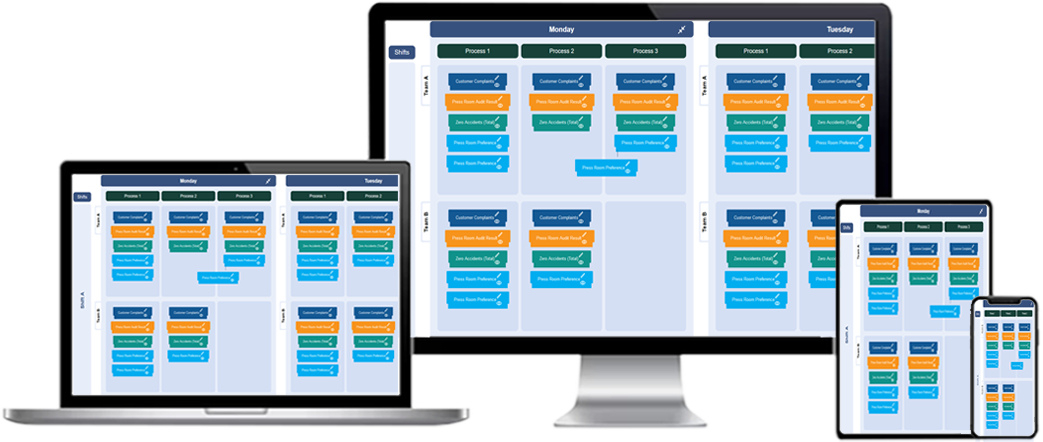Integrating T-Card software with Enterprise Resource Planning (ERP) and Manufacturing Execution Systems (MES) is essential for improving workflow visibility, enhancing production efficiency, and ensuring seamless data exchange across different operational areas. By integrating these systems, businesses can automate task tracking, optimize resource allocation, and improve overall manufacturing performance.

1. Understanding the Role of TCard Software in Manufacturing
T-Card software is a digital task management tool that helps track workflow stages, assign responsibilities, and ensure that tasks are completed on time. It provides a visual representation of work progress, allowing teams to manage operations effectively.
By integrating T-Card software with ERP and MES, manufacturers can achieve:
- Real-time synchronization: Ensures task updates reflect across all systems instantly.
- Improved efficiency: Reduces manual data entry and eliminates redundant processes.
- Enhanced decision-making: Provides a unified view of production workflows.
- Better compliance: Maintains accurate records for auditing and reporting.
2. Key Steps in Integrating TCard Software with ERP & MES
Successful integration requires a structured approach to ensure compatibility, data accuracy, and system efficiency.
Step 1: Define Integration Objectives
Before starting the integration process, define clear objectives based on business needs. Identify key areas where T-Card software will add value, such as task scheduling, production tracking, or workforce management.
Step 2: Assess System Compatibility
Evaluate the compatibility of your T-Card software with existing ERP and MES systems. Ensure that the integration supports:
- Data exchange through API connections.
- Support for industry-standard communication protocols.
- Scalability for future expansion.
Step 3: Establish Data Mapping and Workflows
Define how data will flow between T-Card software, ERP, and MES systems. Common integration points include:
- Task assignments syncing with production schedules.
- Work order updates reflecting in real-time.
- Performance metrics feeding into business intelligence dashboards.
Step 4: Implement API or Middleware Solutions
To enable seamless communication between systems, use:
- Application Programming Interfaces (APIs): Directly connects software components.
- Middleware solutions: Acts as a bridge to standardize data exchange.
Step 5: Test and Validate the Integration
Conduct thorough testing to ensure that all systems function correctly post-integration. This includes:
- Validating data consistency across platforms.
- Ensuring that automated workflows trigger expected actions.
- Identifying and resolving any system errors or bottlenecks.
Step 6: Train Employees and Optimize Usage
Provide training for staff to ensure they understand how to use the integrated system effectively. Focus on:
- Task assignment procedures.
- Data entry and reporting standards.
- Using dashboards for real-time insights.
3. Benefits of Integrating TCard Software with ERP & MES
Integrating T-Card software with ERP and MES systems offers several advantages, including:
- Enhanced Productivity: Reduces manual tasks and speeds up decision-making.
- Better Resource Utilization: Allocates resources efficiently based on real-time data.
- Real-Time Monitoring: Improves visibility into production processes.
- Reduced Errors: Automates data transfer, minimizing human mistakes.
4. Overcoming Common Integration Challenges
During integration, manufacturers may face challenges such as:
- Data Inconsistencies: Ensuring accurate data mapping between systems.
- Technical Compatibility Issues: Addressing API or protocol mismatches.
- Change Management Resistance: Training employees to adapt to new workflows.
To overcome these challenges, businesses should work closely with IT teams, conduct pilot testing, and provide ongoing support to users.
5. Future Trends in TCard and System Integration
As technology evolves, integration between T-Card software, ERP, and MES will continue to improve with:
- AI-Driven Automation: Intelligent scheduling and predictive task management.
- Cloud-Based Integration: Enhanced accessibility and scalability.
- IoT Connectivity: Real-time updates from connected manufacturing devices.
By leveraging these advancements, manufacturers can streamline operations, enhance productivity, and maintain a competitive edge in the industry.
How to Integrate T-Card Software with Your ERP & MES Systems
What is T-Card software integration?
T-Card software integration connects digital task management with ERP and MES systems to enhance workflow visibility and operational efficiency.
Why integrate T-Card software with ERP and MES systems?
Integrating T-Card software ensures seamless data flow between task management, resource planning, and manufacturing execution for better coordination.
How does T-Card software improve workflow in ERP and MES?
T-Card software provides a visual representation of tasks, making it easier to track, assign, and monitor production processes within ERP and MES systems.
What are the key benefits of integrating T-Card software?
Integration improves task tracking, enhances visibility, reduces manual data entry, and streamlines operations between different business systems.
How does data synchronization work between T-Card and ERP/MES?
Data synchronization ensures that updates in T-Card software automatically reflect in ERP and MES, providing real-time accuracy and consistency.
Can T-Card software provide real-time updates to ERP and MES?
Yes, real-time updates allow for instant task tracking, status changes, and workflow adjustments across integrated systems.
How does T-Card software enhance production tracking?
It provides a structured view of ongoing, pending, and completed tasks, helping teams monitor production progress effectively.
What security measures are required for integration?
Secure API connections, user authentication, and data encryption help ensure safe integration of T-Card software with ERP and MES.
How does T-Card software support automated task management?
Automated workflows assign tasks based on predefined rules, reducing manual effort and improving efficiency.
What challenges might arise when integrating T-Card software?
Potential challenges include data mapping issues, compatibility concerns, and the need for user training.
How can T-Card software improve decision-making in ERP and MES?
Real-time task visibility and analytics help managers make informed decisions on production schedules and resource allocation.
Is T-Card software integration suitable for all industries?
Yes, it can be customized for various industries, including manufacturing, logistics, healthcare, and service management.
What reporting and analytics features does integrated T-Card software offer?
It provides detailed reports on task completion rates, efficiency metrics, and process bottlenecks.
How does T-Card software help with resource allocation?
It enables better workforce and material planning by tracking availability and workload distribution.
What steps are involved in integrating T-Card software with ERP and MES?
The process includes system assessment, API configuration, data mapping, testing, and user training for seamless adoption.